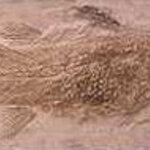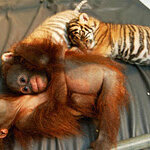Evolution

Cartilaginous fishes (sharks, rays, skates, and chimaeras) are the phylogenetically oldest group of living jawed vertebrates. They are also an important outgroup for understanding the evolution of bony vertebrates such as human and teleost fishes. In a new study published online this week in the open access journal PLoS Biology, Byrappa Venkatesh, Sydney Brenner, and colleagues performed survey sequencing (1.4× coverage) of a chimaera, the elephant shark (Callorhinchus milii).
The elephant shark genome, estimated to be about 910 Mb long, comprises about 28% repetitive elements. Comparative…

Coelacanths are lobe-finned fish, which vary in size but can reach up to 6.4 feet in length and weigh up to 176 pounds. Scientists have inferred that they can live 80 to 100 years. Their closest living relatives are lungfish and as fossils they can be readily identified by their distinctive ‘tail flag’. They were long thought to be extinct because their fossil record seems to disappear quite abruptly along with the dinosaurs and many other creatures at end of the Cretaceous period, 65 million years ago. In the winter of 1938, trawler captain, Hendrik Goosen returned to London after an…

The next time you are struggling to carry your bags home from the supermarket just remember that this could, in fact, be the reason you are able to walk upright on two legs at all! How we have evolved to walk on two legs remains a fundamental but, as yet, unresolved question for scientists. A popular explanation is that it is our ability to carry objects, particularly children, which forced early hominins onto two legs. Dr Johanna Watson (University of Manchester) will present work supporting this theory on Saturday 31st March 2007 at the Society for Experimental Biology's Annual Meeting in…

‘Living Fossil’ is often a term applied to an animal that has a fossil record very far back in time but no close living relatives. This is a loose definition and taxonomists will argue about its specifics but we aren’t going to hash it out. Most people have at some point or another have heard of living fossils and you could probably come up with a list of common suspects: gingko, horsetail, horseshoe crabs, sphenodonts and the platypus, an egg-laying mammal. A popular theory has also pegged the Loch Ness Monster as worthy of living fossil status since it is ‘a…

Recently week pictures were released by Taman Safari Indonesia Animal Hospital & Zoo of two Sumatran tiger cubs and a pair of orangutan babies who have been sharing a home over the last month. All four were orphaned, rescued and are now being housed together at the animal hospital. The snapshots show gentle affection, playful behaviour and even a helpful orangutan feeding a tiger cub.
I am unsure what made the zoo decide to keep these animals together. Perhaps they are experimenting with bonding between species, or may be it was a more logistic matter of space. Regardless, the…

I have been watching way too much CSI. For those who haven’t seen the popular American television show, it is about a team of highly skilled Crime Scene Investigators who use keen observational skills and high tech gadgetry to solve crimes each week in Las Vegas (The franchise also includes Miami and New York).
Well on the way to the coffee house yesterday my husband, Paul, spotted a trail of blood, obviously a fight at one of the local clubs the night before. I know we have been watching too much CSI because before the end of the block we had determined the trail we were examining was the…

If you’re a palaeontologist you’ve heard this question a thousand times. And if you’re not a palaeontologist you might wonder why you never get the same answer twice. Well you see the annoying part of palaeontology is that the most spectacular animals are sometimes only known from a single bone or sometimes a fragment of a bone and so ‘reconstructing’ that animal can be incredibly difficult (and controversial).
The famous French naturalist, Georges Cuvier once said"Today comparative anatomy has reached such a point of perfection that, after inspecting a single bone, one can often determine…

Why mitochondrial genes ditch their cushy haploid environs to take up residence in a large and chaotic nucleus has long stumped evolutionary biologists, but Indiana University Bloomington scientists report in this week's Science that they've uncovered an important clue in flowering plants.
"Plants that reproduce clonally or are capable of self-pollinating have transferred more genes from the mitochondrion to the nucleus," said graduate student Yaniv Brandvain, lead author of the paper.
That discovery, Brandvain explained, is unexpected. The most obvious benefit of being part of the nuclear…

Researchers at the University of California, Santa Cruz, have determined the three-dimensional structure of an RNA enzyme, or "ribozyme," that carries out a fundamental reaction required to make new RNA molecules. Their results provide insight into what may have been the first self-replicating molecule to arise billions of years ago on the evolutionary path toward the emergence of life.
In all forms of life known today, the synthesis of DNA and RNA molecules is carried out by enzymes made of proteins. The instructions for making those proteins are contained in genes made of DNA or RNA (…
Your football coach always told you that the low man wins. Seems that ape-like ancestors may have evolved that way for the same reason.
Australopiths maintained short legs for 2 million years because a squat physique and stance helped the males fight over access to females, a University of Utah study concludes.
"The old argument was that they retained short legs to help them climb trees that still were an important part of their habitat," says David Carrier, a professor of biology. "My argument is that they retained short legs because short legs helped them fight."
This drawing of a male…